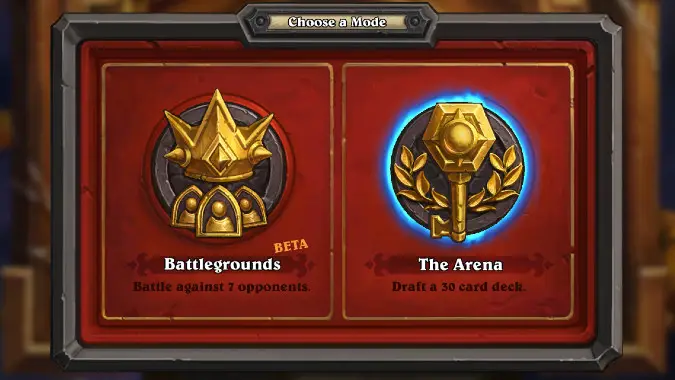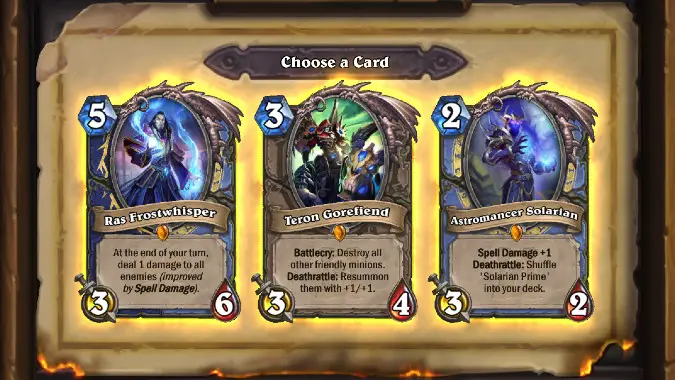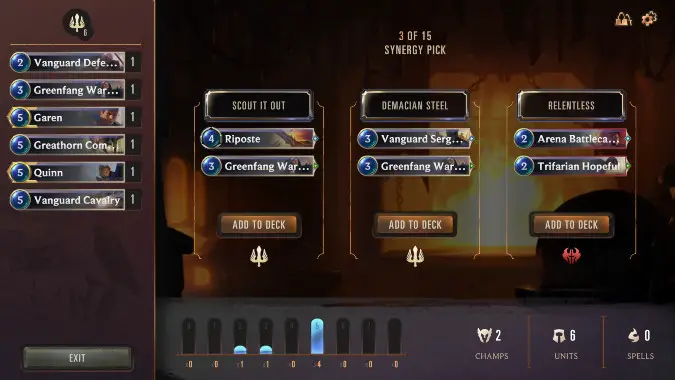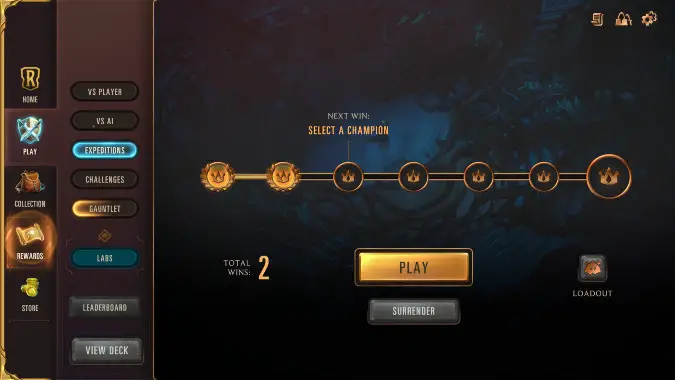Why Hearthstone’s Arena is a bad drafting mode, and how Legends of Runeterra does it much better

If you’ve been following Hearthstone for the past year or so — more specifically, since November 5, 2019, when the Battlegrounds mode was introduced — you’ve probably noticed the steady decline in popularity of its once prominent Arena mode. Many prolific Arena players — some of whom used to attract thousands of viewers when streaming Arena — have since migrated to Battlegrounds and not looked back.
Arena was never the most popular game mode in Hearthstone, but things have only gotten worse since Battlegrounds was added. The game used to offer Constructed and Arena as two different ways to compete. These days, it feels like Arena has been all but replaced by Battlegrounds as the game’s unofficial second mode, and those who still cling to Arena often express that their criticisms have been falling on deaf ears for quite some time now. Arena players feel abandoned — the whole game mode does.
After spending an enormous amount of time away from it, I jumped back into Arena recently — bribed by the Dual Class Arena event that has been temporarily reinstated — and I did not like what I found. At all. The game mode feels incredibly crude and unpolished when compared to everything else that Hearthstone — and other card games, for that matter — can offer. The comparison is especially cruel when you add to it Hearthstone’s main competitor, Legends of Runeterra, which offers its own, very different draft mode called Expedition. I have played Expedition quite extensively over the past few months, and I had fun while doing it. Jumping back into Arena after that was a harsh reality shock.
So let’s talk about what are the main issues that Arena has, how expertly most of those issues have been tackled by Runeterra’s Expedition mode, and how the Hearthstone team could learn from it all.

What are the main problems with Hearthstone Arena?
In Hearthstone Arena, you build a deck of 30 cards, picking one card at a time, from three possible options. You slowly build a deck, making those 30 picks, one by one. The only parameters you have to make each of those choices are the cards you’ve already picked up to that point. You can see what your “deck” — if you can call it that — already has, as well as your mana curve. As such, it is difficult to create synergies — because you don’t know if you’re even going to be offered cards that work well with one another.
This has created a dichotomy in how Hearhtstone players evaluate cards, by separating them into two types: “Constructed” cards and “Arena” cards. Some are great for one mode but terrible for the other. And as time passed and strategies evolved, it became clear that the cards that are good for Arena are, usually, cards that stand on their own, with little to no synergy to any other cards. The cards you want in your Arena deck are those that will make an impact when used, regardless of the situation of the current game. For instance:
- “Big” minions that stick: Cards with high stats and keywords like Divine Shield, or Deathrattle effects that summon other minions.
- High tempo swing cards: Minions with Battlecry effects that allow them to deal damage to or destroy other minions, as well as Rush effects where your cards can destroy an enemy without also destroying your Rush card in the process.
- Board clears and removal: Mostly through spells like Fireball or Flamestrike, which made the Mage class reign supreme in Arena for much of its existence.
There is little to no room for synergy — synergy picks are extremely risky and not recommended. Which goes squarely against everything that makes card games fun. Despite what the game mode proposes that you do, you don’t end up drafting a deck. Instead, you often end up drafting what amounts to a simple collection of cards that are strong on their own but boring — without any fun interactions with one another or crazy combo potential.
Picking strong minions or removal cards and playing them “on curve” — that is, having a strong play that uses up all your mana on every single turn — is very efficient. And that accentuates the problem even further: Players often play all of their strong cards as they’re drawn in the earliest turns, Then, by the end of the game, they’re starved for cards in their hands. The game becomes a “topdeck war” — whoever has luck on their side and draws the strongest big minion (or removal) from the top of their deck has the highest chance to win.
This, in turn, creates a feedback cycle where there is little incentive to engage in counterplay against your opponent, or to attempt to setup a trap for them, or to try to build a game plan that leads to some satisfying payoff in the end via a spectacular combo or interaction. In Hearthstone Arena, you don’t get some of the most satisfying aspects of playing a card game.

How does Runeterra make drafting better than Hearthstone?
If we are to compare Runeterra’s Expeditions to Hearthstone’s Arenas, there are some key differences that jump at us immediately.
You draft “buckets” of cards instead of single cards
In Expeditions, you don’t draft cards one by one until you complete your deck. Instead, you draft “buckets” which contain two to three cards. If you’ve ever played the single-player deckbuilding modes in Hearthstone (e.g., Dungeon Run) you should have a very good idea of what I’m talking about.
This is the most important difference, and the decisive factor that makes the Expedition experience infinitely superior to the Arena one. Each of those buckets is carefully designed so that the cards within it have synergy with one another. You’re not simply drafting random cards and trying to make them fit together — you’re actually drafting small pieces of real, functional decks, and the cards within are actually designed to work together with one another. And what’s more, future buckets that are offered to you are based on which buckets you’ve already picked. So if you start to pick cards that fit into a certain strategy, chances are high that more buckets that also fit into that strategy will show up for you.
When you finish your drafting process, you end up with something that actually resembles a real deck. The distinction between “Constructed cards” and “Arena cards” that exists in Hearthstone is a much smaller problem under this drafting system. Your knowledge of one game mode can frequently translate — almost seamlessly — into the other mode.
This has implications not only to you, the player — who will actually be able to craft a working deck, with its own mechanics, synergies, strong and weak points — but also to your opponent, who will be able to look at the Regions and Champions you picked, and have a much clearer idea of what kind of deck you’re playing and how they should adapt their own strategy to counter yours.
You get a “Trade Pick” after the initial draft
After you finish your draft, you get the chance to fine tune your deck via a Trade Pick. What happens is this: The game will select three cards from your draft and offer replacements for them. You will be able to examine those three possible trades, and decide to go for one of them — or not. If you’re happy with the deck you’ve drafted, you can freely skip this Trade Pick. But if you’re not, you get the chance to fix a mistake or fine tune a strategy.
This is a kind of suggestion that has been proposed by many Hearthstone Arena players over the years. The simplest fix for that game mode that would not require an enormous revamping would be to allow you to draft more than just 30 cards and then discard a few of those cards in the end. That, in itself, would already encourage players to be more daring in their picks, because those final trade-ins would allow them to course correct any mistakes they might have made. The chances of getting synergies around the cards you’ve already picked would increase.

“Champion Picks” and “Trade Picks” after playing games
In Expeditions, the process of drafting your deck does not end after you finish those initial steps and begin playing your games. You get to actually tinker with your deck — including adding Champions to it! — after each new game.
After your first win, you get a Champion Pick. Three buckets, each of them containing one Champion, are offered to you, and you get to add one of them to your deck. Adding a new Champion (or an extra copy of a Champion you already had) to your deck is a huge deal, since Runeterra decks are, more often than not, built around those Champion cards. And it also means, of course, that with each match you win, your deck gets even stronger.
Not only is this exciting — getting to make more choices and to improve your deck is fun, after all — but it also tests the skills of players by changing up their decks with each new win. You can’t simply sit on your laurels if you drafted a very strong deck in the beginning. You need to be skilled — and lucky — to keep drafting well, otherwise your future opponents might catch up to your own deck in power. And the opposite is also true: If your initial deck wasn’t too strong, you get the chance to greatly improve upon it. The result is that, the more games you win, the more powerful everyone’s decks will likely be on the later rounds.
Double-elimination system
In Hearthstone Arena, each Arena run ends once you accumulate either twelve wins or three losses — whichever comes first. That means that, if you are already at two losses, every single game you play becomes a potential elimination game. If the RNG gods aren’t with you, one bad game might end your run.
Expeditions use a double elimination system instead. You are only eliminated once you lose two matches in a row. So if you lose your very first game, you’re on the edge, under the risk of elimination. But if you win your next game, you’re “safe” again. You get the chance to salvage your losses and go back to a pristine position.
The sole exception is the final match. Once you’re at six wins, your seventh game is a single-elimination game — the grand finals, if you will. Win, and you conquer your run, for the best possible prizes. Lose, and your run is over, even if it’s the only game you’ve lost up to that point. These super high stakes make for a much more exciting final game than normal. Like fighting the final boss, on your last life!
Double-trial system for rewards
This is another crucial change that really encourages players to keep trying to improve their ability in Expeditions, even if they’re not the most skilled at the game. An Expedition token does not buy you a single series of games until you’re either eliminated or win it all — but rather, two. Each of those runs is called a “trial.” So even if you “bomb” your first trial, you still have the chance to redeem yourself on the second one. And what’s better: Once you finish both trials, your rewards are based on whichever one you got the best results at. So if, let’s say, you get two wins on the first trial and six wins on the second trial, you get the “six wins” prize!
Overall, a higher number of players will get better rewards upon playing Expedition than what happens in Hearthstone Arena, where the top players will likely win more games and keep hoarding the top prizes. In Runeterra, a less skilled player might still ace one of their trials and get a bite out of the top-shelf goods for themselves, which works out to even out prize distribution in the long run. The result is that playing Expedition is very often going to be rewarding, and you’re unlikely to leave empty-handed.

New game modes are coming to Hearthstone — hopefully they bring some of Runeterra’s systems with them
These are some of the key differences that make Legends of Runeterra’s Expedition mode a much, much better Draft mode than Hearthstone’s Arena. We already know that the Hearthstone developers are working on brand new game modes, and I can only hope that at least one of those modes is a brand-new Draft mode — one that is much stronger than the one we currently have. They don’t even need to replace Arena if they don’t want to, as long as they add a new option. It would be a very welcome addition to Blizzard’s card game, and it would give players another serious competitive avenue besides Constructed and Battlegrounds.
Please consider supporting our Patreon!
Join the Discussion
Blizzard Watch is a safe space for all readers. By leaving comments on this site you agree to follow our commenting and community guidelines.




